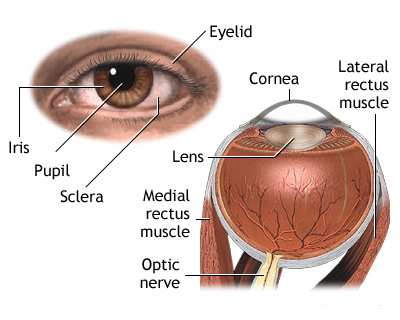Retinal detachment
Retinal detachment is a separation of the light-sensitive membrane in the back of the eye (the retina) from its supporting layers.

CAUSES.
- The most common type of retinal detachments are often due to a tear or hole in the retina. Eye fluids may leak through this opening. This causes the retina to separate from the underlying tissues, much like a bubble under wallpaper. This is most often caused by a condition called posterior vitreous detachment. However, it may also be caused by trauma and very bad nearsightedness. A family history of retinal detachment also increases your risk.
- Another type of retinal detachment is called tractional detachment. This is seen in people who have uncontrolled diabetes, previous retinal surgery, or have chronic inflammation.
When the retina becomes detached, bleeding from area blood vessels may cloud the inside of the eye, which is normally filled with vitreous fluid. Central vision becomes severely affected if the macula, the part of the retina responsible for fine vision, becomes detached.
SYMPTOMS
- Bright flashes of light, especially in peripheral vision
- Blurred vision
- Floaters in the eye
- Shadow or blindness in a part of the visual field of one eye
EXAMS AND TESTS
Tests will be done to check the retina and pupil response and your ability to see colors properly. These may include:
- Electroretinogram (a record of the electrical signals in the retina produced when you see things)
- Fluorescein angiography
- Intraocular pressure measurement
- Ophthalmoscopy
- Refraction test
- Retinal photography
- Test to determine your ability to see colors properly
- Visual acuity
- Slit-lamp examination
- Ultrasound of the eye
TREATMENT
Most people with a retinal detachment will need surgery. Surgery may be done immediately or after a short period of time.
Surgery may not be needed if you do not have symptoms or have had the detachment for a while.
Some types of retinal detachment surgery can be done in your doctor's office.
- Lasers may be used to seal tears or holes in the retina before a retinal detachment occurs.
- If you have a small retinal detachment, the doctor may place a gas bubble in the eye. This is called pneumatic retinopexy. It helps help the retina float back into place. The hole is sealed with a laser.
More severe detachments may require surgery in a hospital operating room. Such procedures include:
- Scleral buckle to gently push the eye wall up against the retina
- Vitrectomy to remove gel or scar tissue pulling on the retina, used for the largest tears and detachments.
Tractional retinal detachments may be watched for a while before surgery. If surgery is needed, a vitrectomy is usually done.
PROGNOSIS
How well you do after a retinal detachment depends on the location and extent of the detachment and early treatment. If the macula was not damaged, the outlook with treatment can be excellent.
Most retinal detachments can be repaired, but not all of them. You may not get back all of your vision after surgery.
POSSIBLE COMPLICATIONS
A retinal detachment causes loss of vision. Surgery to repair it may help restore some or all of your vision.
WHEN TO CONTACT ВРАЧА
A retinal detachment is an urgent problem that requires medical attention within 24 hours of the first symptoms.
PREVENTION
Use protective eye wear to prevent eye trauma. Control your blood sugar carefully if you have diabetes. See your eye care specialist at least yearly, especially if you have risk factors for retinal detachment.

